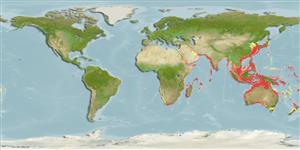Common names from other countries
Environment: milieu / climate zone / depth range / distribution range
Ecologia
marinhas demersal; intervalo de profundidade 10 - 200 m (Ref. 121768). Tropical; 36°N - 34°S, 24°E - 154°E
Indo-West Pacific: Algoa Bay, South Africa to southern Japan and Australia.
Comprimento de primeira maturação / Tamanho / Peso / Idade
Maturity: Lm 30.0 range ? - ? cm
Max length : 90.0 cm SL macho/indeterminado; (Ref. 559)
Descrição suscinta
Chaves de identificação | Morfologia | Morfometria
Espinhos dorsais (total) : 0; Raios dorsais (total) : 12 - 14; Espinhos anais: 0; Raios anais : 10 - 12. Dorsal part of body without prickles, belly covered with prickles (Ref. 559). Greenish or dark grey above, silvery white below (Ref. 4919). Distinguished from other Lagocephalus species by the black gill opening (Ref. 559).
Found in the shelf edge (Ref. 11230). Closely resembles the Atlantic species L. laevigatus Linnaeus which reaches southern Angola (Ref. 4919).
Ciclo de vida ou comportamento de acasalamento
Maturities | Reprodução | Spawnings | Egg(s) | Fecundities | Larvas
Smith, M.M. and P.C. Heemstra, 1986. Tetraodontidae. p. 894-903. In M.M. Smith and P.C. Heemstra (eds.) Smiths' sea fishes. Springer-Verlag, Berlin. (Ref. 4919)
Status na Lista Vermelha da UICN (Ref. 130435)
CITES (Ref. 128078)
Not Evaluated
Ameaça para os humanos
Poisonous to eat (Ref. 559)
Uso pelos humanos
Ferramentas
Relatórios especiais
Baixar XML
Fontes da internet
Estimates based on models
Preferred temperature (Ref.
115969): 16.6 - 28.3, mean 26.4 (based on 1313 cells).
Índice de diversidade filogenética (Ref.
82804): PD
50 = 0.5005 [Uniqueness, from 0.5 = low to 2.0 = high].
Bayesian length-weight: a=0.02692 (0.01730 - 0.04187), b=2.86 (2.74 - 2.98), in cm Total Length, based on LWR estimates for this species & Genus-body shape (Ref.
93245).
Nível Trófico (Ref.
69278): 3.9 ±0.4 se; based on size and trophs of closest relatives
Resiliência (Ref.
120179): Baixo, tempo mínimo de duplicação da população 4,5 - 14 anos (K=0.53).
Fishing Vulnerability (Ref.
59153): Moderate vulnerability (36 of 100).
